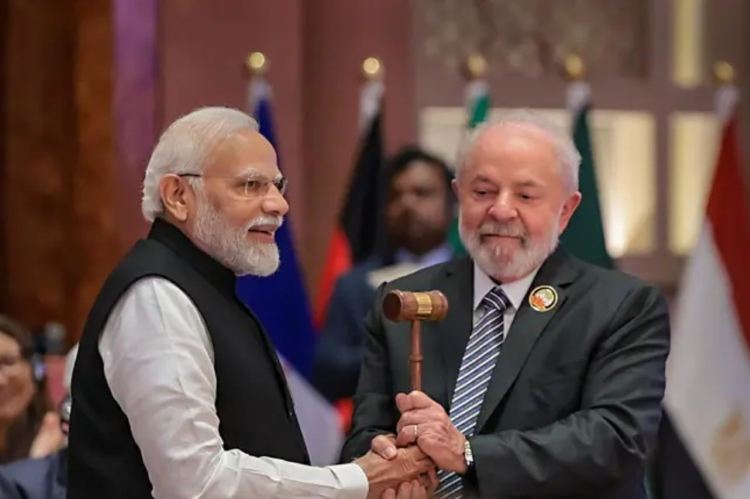External affairs Minister S Jaishankar met his American, Japanese and Australian counterparts in Washington on July 1 to renew the Quad’s pledge to keep Indo-Pacific waters “free, open and under the rule of law.” Three days later Prime Minister Narendra Modi will land in Rio de Janeiro for the BRICS summit, where the rhetoric will revolve around de-dollarisation, development finance and a louder voice for the Global South.
The diplomatic choreography captures New Delhi’s high-wire act: court Washington for technology and defence while championing multipolarity inside the bloc. Yet that very closeness to the United States now threatens to blunt the bloc’s core economic ambitions. As BRICS seeks an alternative payments architecture and unified trade positions, India’s growing alignment with Washington introduces hesitation, dilutes consensus and risks turning the grouping into little more than a photo-op.
The timing is unmistakable. The Quad foreign ministers’ statement of July 1 not only announced new maritime-law-enforcement and supply-chain initiatives; it singled out the Pahalgam terrorist attack—language India could not persuade the Shanghai Cooperation Organisation to adopt. Security alignment with Washington thus deepens just as Presidents Xi Jinping and Vladimir Putin decide to skip the Rio summit, depriving BRICS of the political heft needed to push their de-dollarisation agenda. A Chatham House paper published this week is blunt: India’s back-to-back engagements with Quad and BRICS “underscore an increasingly difficult balancing act.”
READ I BRICS+ meets in Rio amid global shifts and internal fractures
A fragile consensus on de-dollarisation
For Moscow and Beijing, insulating trade from US sanctions is existential; for Brasília and New Delhi, it ranks below access to American markets and technology. President Donald Trump’s revived tariff threat last week—100 per cent duties if BRICS challenges the dollar—was a pointed reminder. New Delhi therefore limits itself to settling a sliver of bilateral trade in local currencies. India’s 2024 goods deficit with China reached $94 billion and with Russia $59 billion, pushing its BRICS-wide deficit to $209 billion. A common currency built on such imbalance is fiscally reckless and politically indefensible.
The dilemma tightens this week. A freeze on Trump’s reciprocal tariffs expires on July 9; without an interim pact, duties of up to 26 per cent will clobber Indian exports. Commerce minister Piyush Goyal insists India “does trade deals in the national interest, not to meet deadlines,” yet negotiators scramble. If Washington waives tariffs, BRICS partners will see proof of India’s privileged access; if talks fail, dependence on the US market will deepen, narrowing space to back bold BRICS initiatives. Either way, consensus inside the bloc shrinks.
Widening deficits, narrowing ambitions
India’s merchandise trade with BRICS has grown at a brisk 20 per cent CAGR since 2020, yet deficits grow faster, driven by 1.76 million bpd of Russian oil and a flood of Chinese electronics. BRICS suppliers now provide 59 per cent of India’s crude. Meanwhile the Quad offers what BRICS cannot: semiconductor partnerships, fintech corridors and defence co-production; its July 1 communiqué floated new working groups on trusted AI chips and under-sea-cable security—topics absent from the BRICS docket.
Expansion has also skewed BRICS toward energy exporters and autocracies, unsettling democratic members. India vetoed Türkiye last year and remains uneasy about Saudi Arabia’s pending entry, each addition amplifying China’s weight and nudging New Delhi closer to Washington.
Re-centring the BRICS agenda
If BRICS is to remain relevant, the bloc must move from headline-grabbing slogans to incremental, bankable projects. India can help craft that trajectory without jettisoning its American partnership. One path is to pilot rupee-denominated settlements in energy and agriculture, building confidence and liquidity before venturing into a basket-currency scheme. Another is to press for clear, objective entry criteria so that enlargement strengthens rather than dilutes collective bargaining power.
Just as crucial is turning the New Development Bank into a co-financier of supply-chain diversification—beginning with electronics and renewables—so that India’s chronic deficits with China and Russia become manageable rather than malignant. Together, these steps would demonstrate that New Delhi’s embrace of Washington is strategic, not exclusive, and that it remains committed to a BRICS economic agenda grounded in realism rather than rhetoric.
BRICS was conceived as a counterweight to Atlantic orthodoxy; today it risks irrelevance if members pursue divergent priorities. India’s challenge is to prove that strategic autonomy still lives, not as nostalgic slogan but as practical statecraft.
Should New Delhi fuse its American alliance with a credible plan to deepen South-South finance and trade, BRICS could yet evolve into a genuine economic pole. Otherwise, the real business of technology, money and security will migrate to US-led tables where India is present but peripheral—and the promise of a multipolar order will recede with the Brazilian tide.

